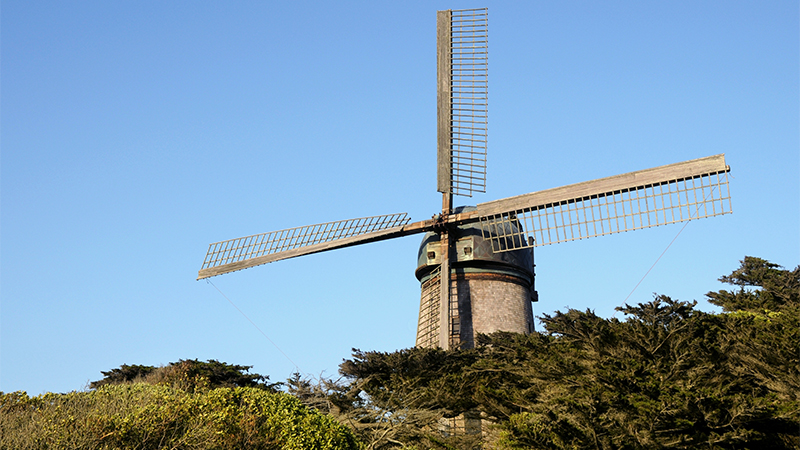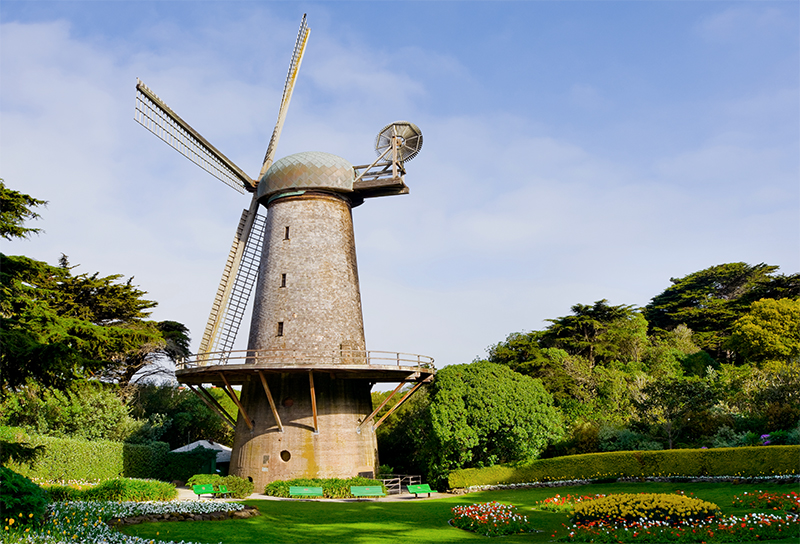
Today Golden Gate Park’s two historic windmills, the north windmill, called the Dutch Windmill and the south windmill, called the Murphy Windmill stand tall, overlooking Ocean Beach at the western edge of the park. These relics of the past tower above the trees as reminders of the park’s creation.
Golden Gate Park was planted on sand dunes, and the inland ground water wasn’t enough to sustain the park’s lush lawns and gardens or to fill the park’s man-made lakes and fuel the artificial waterfalls.
In 1902, after heavy lobbying by Park Superintendent John McLaren, the Dutch Windmill was built to pump the extra irrigation water Golden Gate Park needed. Designed by San Francisco resident Alpheus Bull Jr., construction of the North Windmill cost $25,000 and the fund were donated by Queen Wilhelmina, former Queen of the Netherlands. A cottage was also built for a caretaker live in while maintaining the windmill.

At 75 feet tall, the Dutch Windmill pumped 30,000 gallons of water per hour and was used to fill the artificial park ponds of Lloyd Lake, Metson Lake, and Spreckels Lake. It was such a success that construction of the second windmill, the Murphy Windmill, began in 1905. It was completed in 1907 after delays caused by the 1906 earthquake, and was in use by 1908.
By 1913, motorized pumps were installed in the Golden Gate Park Windmills to augment the power system. They no longer relied on the wind, and eventually were closed down. As time passed, the old windmills fell into disrepair.
In 1964, the San Francisco Citizens Commission for the Restoration of the Golden Gate Park Windmills was formed and led by Eleanor Rossi Crabtree, daughter of former San Francisco mayor Angelo Rossi. Repairs to the exterior of the northern Dutch Windmill were completed in 1980. In the 1990s, another campaign called the Campaign to Save the Golden Gate Park Windmills was created, and in the early 2000s both windmills received a complete restoration.
Queen Wilhelmina Tulip Garden
Next to the Dutch Windmill is the Queen Wilhelmina Tulip Garden, named in 1962 for the late queen of the Netherlands who donated the funds for the Dutch Windmill to San Francisco in 1902. For the Netherlands, tulips became a symbol of peace and reconciliation, which served as a reminder of the extended hands offered to the Dutch during their time of war and reconstruction.
While the ideal time to visit the colorful garden is March and April when thousands of tulips and Icelandic poppies are in bloom, you’ll find a wide variety of annuals in bloom year-round.
Know Before You Go
- The Dutch Windmill, also called the North Windmill, is located at 1691 John F Kennedy Dr, San Francisco, CA 94121.
- The Windmill was placed on the San Francisco Designated Landmark list December 1981 as Landmark #147.
- The closest restrooms are across the street on the first floor of the Beach Chalet.
- The Queen Wilhelmina Tulip Garden, located at 1690 John F Kennedy Dr, San Francisco, CA 94121, is next to the Dutch Windmill. The best time to visit is in the months of March and April. It is closed every year for the months of May and October for re-planting.
- With a few benches and a large open gassy area, the Queen Wilhelmina Tulip Garden is the perfect place to spread out a blanket and relax in the sun, enjoy a picnic, or bring a good book.










